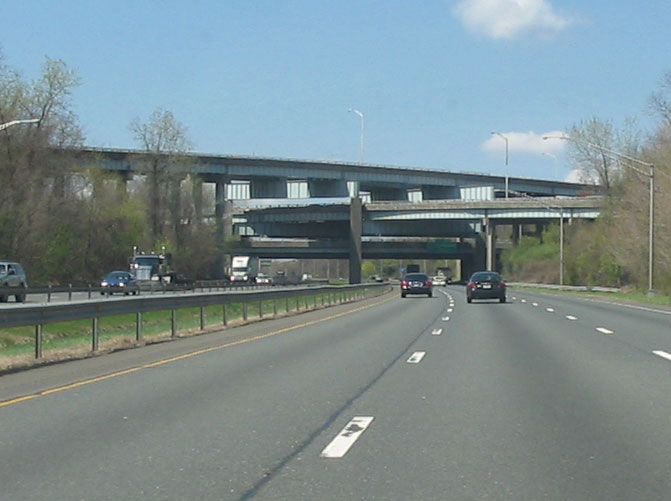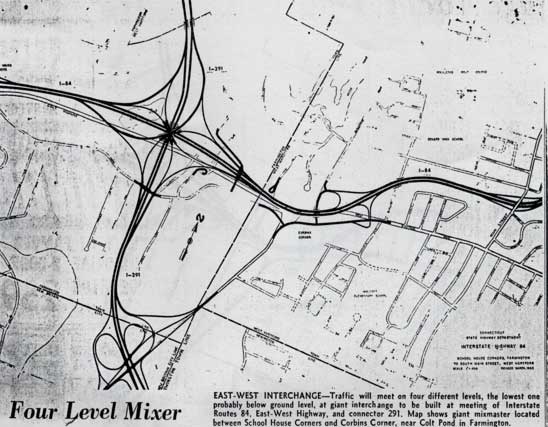Updated Oct 20, 2018



In Farmington, a western suburb of Hartford, rises Connecticut's only four-level stack interchange. It's impossible to miss as you're driving by on I-84, and even Connecticut residents with no professed interest in highways probably know a fact here and there: that it stood completely unused for more than 20 years; that it was intended for a beltway that was later cancelled; that the state is now using part of it.
The word "cyclopean" comes to mind as you approach the interchange (if you've read a little H. P. Lovecraft). It dwarfs other highway features in the area, and has the look of an ancient ruin rising out of the forest. This effect was even more acute when no part of it was in use; now that Route 9 connects to I-84 here, there are some signs of life on connector ramps.
 Approaching stack interchange on I-84 westbound. Photo taken April 2004 by Kurumi.
Approaching stack interchange on I-84 westbound. Photo taken April 2004 by Kurumi.
Highways are built on a grand scale, and "mistakes" are easy targets for mockery by the general public, even among those not particularly interested in transportation. The Stack never had any "Evel Knievel" ramps -- elevated roadways ending in midair -- but its sheer size made it the symbol for imagined DOT hubris and ineptitude.
At least one prankster has erected an unofficial sign on the interchange; at the prompting of a local radio station, someone attached a "Neverpass" sign above the eastbound I-84 lanes (see story).
In the mid-1980s, a poster-size birds-eye view of the Hartford area depicted a man fishing off the end of an empty Stack roadway (again, not accurate, because none of the ramps end in midair).
Plans for I-84 in the area -- the East - West Expressway -- date back to the 1940s. Plans for a circumferential freeway, I-291, date to the late 1950s. Existing roadways in the area were US 6 (the Colt Highway and New Britain Avenue) intersecting Route 71 at a rotary at Corbins Corner. By 1962 the alignments of I-84 and I-291 were well defined in the area, and there was a plan for the state's first four-level stack interchange.
 Diagram of proposed stack interchange, by Connecticut Highway Department, as shown in Hartford Times, August 2, 1963.
Diagram of proposed stack interchange, by Connecticut Highway Department, as shown in Hartford Times, August 2, 1963.
A few other notable items on the diagram:
The design was panned by some citizens. One 1962 letter to the Hartford Courant included the Highway Department diagram with the Rockledge Golf Course boundary overlaying the interchange, drawn to the same scale. There wasn't much room left over for playing golf. Here's part of the letter text:
Typical of the double talk that seems to dominate the local scene is Gov. Dempsey's urgent appeal to preserve our open spaces for posterity while at the same time letting his highway commissioner run rampant through community after community with his bizarre, expensive, idiotic, and utterly useless highway patterns scattered all over the pleasant countryside.
The can of worms concept in East Hartford and the concrete and steel beanstalk laid on its side east of Constitution Plaza are bad enough. But now comes the ne plus ultra, the ultimate goal of the highway fanatics -- a replica of the famous (or infamous) Los Angeles "stack"... a four-level monstrosity soaring up to the height of a five-story building -- three bridges stacked above the other and spread over more than 200 acres of land -- larger than some 18-hole golf courses and about the size of Disneyland...
As the late 1960s arrived, Interstate 84 was nearly complete in Connecticut; the last segments to be built were between Plainville and Hartford, including the Stack area in Farmington. Bids for the stack interchange were let in fall 1967, and work was completed one to two years later. At this time, plans for I-291 were quite active, and the beltway was expected to be finished around 1972. The Stack was constructed in anticipation of being needed in a few years.
In 1970, however, I-291 ran into some big problems, primarily with the MDC reservoirs in West Hartford, north of I-84 and the Stack. Some alternate routes were discussed, but by 1973 I-291 north of I-84 was cancelled. In late 1973 work on the southwest quadrant was halted, and soon that segment was cancelled as well.
The Stack was orphaned, and for more than 20 years I-84 passed beneath three levels of unused roadways.
On September 30, 1992, Route 9 was connected to I-84 at the Stack, and some of its ramps were opened to traffic for the first time. Since Route 9 ends at I-84, making a three-way interchange, several ramps of the Stack are still unused.
The state made wise use of part of the Stack for Route 9; but will the rest of the interchange ever be utilized? There are no plans to extend Route 9, nor any public plans for such things as a Route 4 connector. The closest I've seen were proposals in 1997 and 1998 to build a new four-lane or two-lane road from the Stack northward to US 44 in Avon.